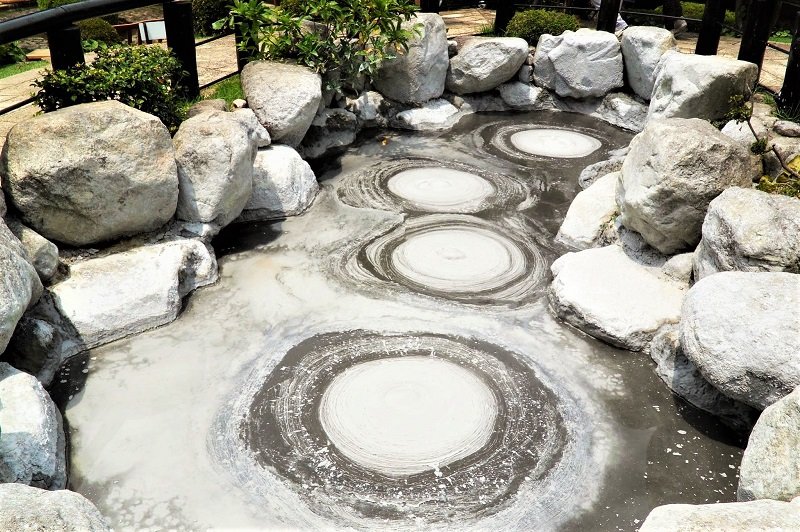
Oddviser
adventure's step-by-steprecipes & lifehacks
How to ride a board on volcano in Nicaragua?How to walk inside the active volcano in Greece?How to feed flying dogs in the jungles of Thailand?How to cycle along the Great Wall of China?How to swim in the famous Trevi Fountain in Rome?How to ride a kayak along the canals of Venice?How to walk on the roofs of skyscrapers in Dubai?
The volume of thermal hot water in Beppu hot springs is the second biggest in the world.

Beppu city is called the capital of hot springs of Japan - there are more than 2800 of them on the city territory. Waters of some mineral hot springs reach boiling temperature that's why they are called the Hell of Beppu.
• Umi Jigoku is the first of the Nine Hells. The water here is turquoise, its temperature is 90°C.
• Oniishibozu Jigoku is boiling grey mud with bubbles that resemble heads of Buddhist monks.

• Shiraike Jigoku Hell is full of milk colour (because of calcium) boiling water and surrounded with flora.

• Yama Jigoku - the fourth hot spring - resembles rather mud volcano.
• Kamado Jigoku consists of a few boiling springs that are guarded the statue of cook demon.
• Oniyama Jigoku spring harbours hundreds of crocodiles.
• The statue of dragon blowing off steam out of the mouth stands next to Kinryu Jigoku geyser - at sunrise it seems like the dragon is flying up.
• Water in the most popular hot spring of Japan - Chinoike Jigoku - is bright scarlet colour because of big number of iron-bearing minerals and the water temperature reaches 90°C.

• The ninth spring Tatsumaki Jigoku is a geyser spurting up to 20 meters every 30 minutes.
• Umi Jigoku is the first of the Nine Hells. The water here is turquoise, its temperature is 90°C.
• Oniishibozu Jigoku is boiling grey mud with bubbles that resemble heads of Buddhist monks.

• Shiraike Jigoku Hell is full of milk colour (because of calcium) boiling water and surrounded with flora.

• Yama Jigoku - the fourth hot spring - resembles rather mud volcano.
• Kamado Jigoku consists of a few boiling springs that are guarded the statue of cook demon.
• Oniyama Jigoku spring harbours hundreds of crocodiles.
• The statue of dragon blowing off steam out of the mouth stands next to Kinryu Jigoku geyser - at sunrise it seems like the dragon is flying up.
• Water in the most popular hot spring of Japan - Chinoike Jigoku - is bright scarlet colour because of big number of iron-bearing minerals and the water temperature reaches 90°C.

• The ninth spring Tatsumaki Jigoku is a geyser spurting up to 20 meters every 30 minutes.
How to do?
1. Kamenoi buses №№ 2, 5, 9, 24, 41 run to the hot springs from Beppu station. It takes 20 minutes to Ironwheel station. Taxi drive takes 15 minutes and costs 2000 yens.
2. In front of the entrance to the hot springs there is a ticket desk - buy a tear-off book with 9 tickets (one for each hot spring). It'll take you 2 hours to walk around the whole Beppu Hell territory and warm your legs in the least hot spring.
2. In front of the entrance to the hot springs there is a ticket desk - buy a tear-off book with 9 tickets (one for each hot spring). It'll take you 2 hours to walk around the whole Beppu Hell territory and warm your legs in the least hot spring.
Where to do?

 Beppu hot springs
Beppu hot springsIn Beppu city that is in the east of Kyushu island there are more than 2800 mineral hot springs. The most popular ones are the Nine Hells of Beppu (Jigoku). You can see them any day from 8am till 5pm. Entry ticket is 400 yens.
4When to do?
Jigoku park is open daily from 8am till 5pm. It is better to come here in the morning.
How much?
Entrance fee to the hot springs territory is 400 yens for adults, 300 yens for students and 200 yens for disabled people.
Entrance fee with excursion is 2000 yens for adults, 1350 yens for students and 550 yens for disabled people.
Entrance fee with excursion is 2000 yens for adults, 1350 yens for students and 550 yens for disabled people.



 по-русски
по-русски en Español (pronto)
en Español (pronto)
Reviews